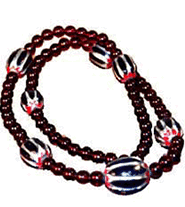African Jewelry
The continent of Africa produces many wonderful jewelry in the past. The great part of the African jewelry is that northern Africa is known to make silver work, plain and enameled, of the Tuareg and other desert peoples. Many African kingdoms made rings, earrings, bracelets, and other ornaments out of gold in Ghana, amber in Songhai, ivory and brass in Benin, and bronze in Yoruba. African jewelry has a lot of beads of shell and of glass that have long been import elements of the African personal adornment all over Africa. Jewelry in Africa has also been used as religious symbols, like the crosses in Ethiopia, and jewelry was also used to indicate social or economic status. Today African people use jewelry in traditional themes with modern materials.
Each African tribe has its own jewelry. Saharan jewelry is characterized by traditional symbols. Authentic African jewelry is referred to Canaanites as it is in the Bible. The fine etchings and associated beliefs are a collusion of Islam, West African animism and Christian ideologies.
The Tuareg Insignia Choker which is a traditional jewelry is known as the protective symbols. This pendant is suspended upon a hand formed sturdy pure silver choker. Africans use jewelry has fashion and for style. They like wearing loose beaded jewelry that will name noise when they dance. Africans have jewelry for a lot of occasions. They use beads, silver and gold to make jewelry. Africans wear jewelry on their head, nose, ears, fingers, and toes.
The kingdom of Benin is located in the tropical rain forest of southern Nigeria. Here the “Oba” rules over the life and death of his subjects. In the Equatorial rain forest, ivory is plentiful and valued for its rich patina and magical powers. People of royalty in Benin wear hip ornaments made from brass that are worn for very special events. These are intricately carved and are held in high regard by its people. The Oba, or king is celebrated by the wearing of these pieces. The method of making these pieces is called bronze casting. The lost wax method of bronze casting was started in the thirteenth century by the Yoruba. The process was done by modeling a form in beeswax and coating it with clay. When the clay is dried, it is heated and melted wax is poured through vents into a hollow mold. When it has cooled the clay coating is broken away. Many pieces of jewelry are made by this method including wide bracelets that are worn by women in Nigeria. These bracelets are worn to entice young men, limit movement of walking, affording them a handsome wiggle. They are made of thin plait brass, are very wide and are not removed for many years.
One of the groups located in the rain forest region is known as the Yoruba. Their religion has many spirits, more commonly known as orishas. Because of these beliefs, many ornaments are worn and designed according to the wearers group and can protect against evil spirits. The Yoruba still believe that the buried ancient glass beads that belonged to chiefs and kings in the region are growing like plants on the ground and are worth their weight in gold. This prompted the blacksmiths in the fourteenth century to make their own beads from clay and even today, fine replicas have been made from his material.
HOME
Indian Handcrafted Jewelry
African Jewelry
Middle Eastern Jewelry
Spanish Jewelry
American Indian Jewelry
SITE MAP

